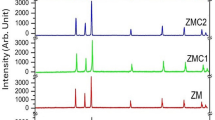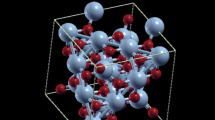Abstract
Energy band-gap engineering via impurity intercalation into the 2-D MoO3 bilayer lattice has been studied using density functional theory calculations, and the effects of various kinds of dopants on the electronic structure have been explored. The dopants were incorporated via both oxygen and molybdenum substitution. The results show that although the MoO3 bilayer is an indirect band-gap semiconductor with zero magnetization, doped molybdenum trioxide experiences a band-gap reduction and a pure magnetization. Based on the calculated results, impurity do** leads to the creation of impurity levels inside the band-gap, and thereby both types of conductivity (n type and p type) can be identified. The calculated impurity formation-energies indicate that Nb and W atoms can be readily incorporated into the MoO3 bilayer.
Similar content being viewed by others
References
L. Zheng, Y. Xu, D. ** and Y. **e, Chem. of Mater. 21, 5681 (2009).
M. Quevedo-Lopez, R. Reidy, R. Orozco-Teran, O. Mendoza-Gonzalez and R. Ramirez-Bon, J. Mater. Sci.: Mater. Electron. 11, 151 (2000).
B. W. Faughnan and R. S. Crandall, Appl. Phys. Lett. 31, 834 (1977).
A. Kyaw, X. Sun, C. Jiang, G. Lo, D. Zhao and D. Kwong, Appl. Phys. Lett. 93, 221107 (2008).
G. H. Jung, K. Hong, W. J. Dong, S. Kim and J. L. Lee, Adv. Energy Mater. 1, 1023 (2011).
L. Kihlborg, Arkiv for Kemi 21, 357 (1963).
J. Parise, E. McCarron, R. Von Dreele and J. Goldstone, J. Solid State Chem. 93, 193 (1991).
A. Bouzidi, N. Benramdane, H. Tabet-Derraz, C. Mathieu, B. Khelifa and R. Desfeux, Mater. Sci. Eng. B 97, 5 (2003).
J. Z. Ou, J. L. Campbell, D. Yao, W. Wlodarski and K. Kalantar-Zadeh, J. Phys. Chem. C 115, 10757 (2011).
J. W. Rabalais, R. J. Colton and A. M. Guzman, Chem. Phys. Lett. 29, 131 (1974).
A. Castellanos-Gomez, M. Poot, G.A. Steele, H. S. van der Zant, N. Agrait and G. Rubio-Bollinger, Adv. Mater. 24, 772 (2012).
K. A. N. Duerloo, M. T. Ong and E. J. Reed, J. Phys. Chem. Lett. 3, 2871 (2012).
H. Tagaya, K. Ara, J. i. Kadokawa, M. Karasu and K. Chiba, J. Mater. Chem. 4, 551 (1994).
X. Sha, L. Chen, A. C. Cooper, G. P. Pez and H. Cheng, J. Phys. Chem. C 113, 11399 (2009).
M. Mansouri and T. Mahmoodi, Acta Physica Polonica A 129, 8 (2016).
S. S. Mahajan, S. H. Mujawar, P. S. Shinde, A. L. Inamdar and P. S. Patil, Sol. Energy Mater. Sol. Cells 93, 183 (2009).
P. Giannozzi, S. Baroni, N. Bonini, M. Calandra, R. Car, C. Cavazzoni, D. Ceresoli, G. L. Chiarotti, M. Cococcioni and I. Dabo, J. Phys. Cond. Matt. 21, 395502 (2009).
H. J. Monkhorst and J. D. Pack, Phys. Rev. B 13, 5188 (1976).
R. Coquet and D. J. Willock, Phys. Chem. Chem. Phys. 7, 3819 (2005).
L. Wang, T. Maxisch and G. Ceder, Phys. Rev. B 73, 195107 (2006).
J. P. Perdew, K. Burke and M. Ernzerhof, Phys. Rev. Lett. 77, 3865 (1996).
J. P. Perdew, J. Chevary, S. Vosko, K. A. Jackson, M. R. Pederson, D. Singh and C. Fiolhais, Atoms, Phys. Rev. B 46, 6671 (1992).
G. Andersson and A. Magneli, Acta Chem. Scand 4, 793 (1950).
D. O. Scanlon, G. W.Watson, D. Payne, G. Atkinson, R. Egdell and D. Law, J. Phys. Chem. C 114, 4636 (2010).
H. Martínez, J. Torres, L. López-Carreño and M. Rodríguez-García, J. Superconductivity Novel Magnetism 26, 2485 (2013).
R. Erre, M. Legay and J. Fripiat, Surf. Sci. 127, 69 (1983).
F. Corü, A. Patel, N. M. Harrison, C. Roetti and C. R. A. Catlow, J. Mater. Chem. 7, 959 (1997).
M. Chen, U. Waghmare, C. Friend and E. Kaxiras, J. Chem. Phys. 109, 6854 (1998).
Author information
Authors and Affiliations
Corresponding author
Rights and permissions
About this article
Cite this article
Mahmoodi, T., Mansouri, M. Structural effects of substitutional impurities on MoO3 bilayers: A first principles study. Journal of the Korean Physical Society 69, 1439–1444 (2016). https://doi.org/10.3938/jkps.69.1439
Received:
Accepted:
Published:
Issue Date:
DOI: https://doi.org/10.3938/jkps.69.1439




